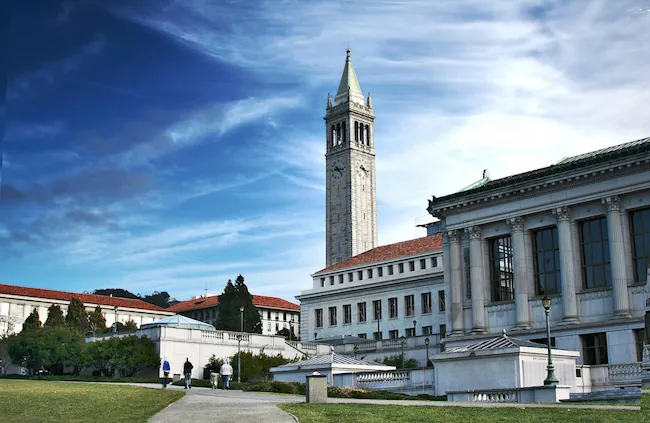
The picturesque University of California-Berkeley campus, where students have the highest cost of living. Courtesy photo
With the cost of college continuing to rise, students and their families are looking for savvy ways to cut down on the expense. A couple of the big decisions surrounding that is where specifically to attend college and whether to live on- or off-campus. On the one hand, living on-campus usually only requires a nine-month lease compared to a 12-month lease often seen off campus. But on the other, posh dorms can sometimes drive up the cost more so than a modest off-campus apartment.
Either way, geographical location matters. And the spread in cost of living at 48 cities and towns examined by Trulia, a popular online real estate site, is massive. For instance, if you decide to attend Ball State University in Muncie, Indiana, you’re looking at a two-bedroom rent of about $600 — or $300 a piece. But for students at the University of California-Berkeley — located in the Bay Area’s heated rent market — you’re looking at $1,697 for one bedroom in a two bedroom apartment.
To be sure, those aren’t isolated examples. The majority of the lower cost of living towns and cities are located in the Southeast and Midwest, while the most expensive spots are along the coasts — mainly towards the West Coast. Following Muncie, Indiana as the most affordable town is Greenville, North Carolina, home of East Carolina University, where students can live off-campus for $359 a piece in a two-bedroom spot. Next is Lynchburg, Virginia, where students at Liberty University can expect to pay $401 a piece for a two-bedroom apartment. All 10 of the most inexpensive towns come from a Midwestern or Southeastern town.
On the other side, four of the six most expensive towns are located in California. In addition to Berkeley, Santa Cruz, San Luis Obispo, and Davis all make the list for California. The other two cities in the top six most expensive are Cambridge, Massachusetts and Boulder, Colorado.
TO LIVE ON-CAMPUS OR OFF-CAMPUS?
The survey also compared costs living on-campus versus off-campus and found that in large college cities such as Berkeley, it was more affordable to live on-campus, with students paying $400 less to live on-campus. Trulia predicts a nine-month “normalized” rent in Berkeley to cost $2,263. An on-campus equivalent space was found to cost $1,861, for a $402 difference per month.
In Fort Collins, Texas, another large college town, it’s better for students to live off-campus. Students could save $400 by not living in a school dorm, with an on-campus space costing $1,444, and an off-campus space costing slightly over $1,000.
For the survey, Trulia looked at census-defined places with at least 45,000 people in the 2016 5-year U.S. Census’ American Community survey where at least 20 percent of the population identified as enrolled in college or graduate school. It took on-campus housing costs from college websites and meal plan costs were excluded where possible, and prices adjusted to compare by month, or semester. To get off-campus living costs, the survey took the median estimated 12-month rental cost of all two-bedroom units in a place, split that between two roommates, and divided it over the nine-month academic year to compare by month.
BETTER OFF-CAMPUS FOR MORE THAN HALF OF THE TOWNS
In 28 of the 48 places the survey was conducted, it found that it was either the same price or cheaper to be off-campus, with average savings of $219 per month for those with a roommate. The biggest savings from living on-campus went to students at California Polytechnic State University in San Luis Obispo, where students in dorms paid $636 less the city’s median rent of $1,553.
However, figuring out where to live isn’t just about comparing price tags, as the survey notes that campus living often includes meal plans at the schools cafeterias and cafes, as well as utilities. Living off campus usually also means longer traveling time to classes and transportation costs. If the difference in price is marginal, and utilities are significant, the attractiveness of either space can easily be reversed.
The survey found that students at Ball State University in Muncie, Indiana, paid the largest premium to live on campus, handing over more than $700 more every month compared to classmates who live off-campus. While significant, the amount becomes more reasonable once off-campus residents find themselves paying for food, transportation, and utilities.
(See the next page for the full data set.)











Questions about this article? Email us or leave a comment below.